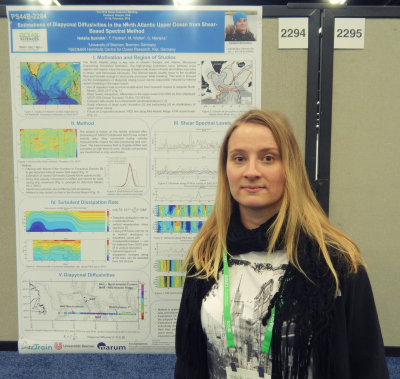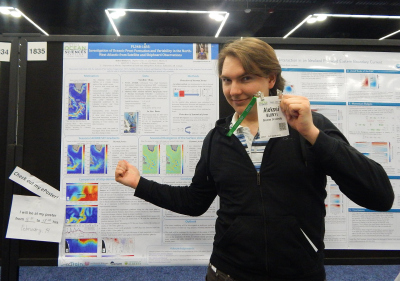- ArcTrain
- Training reports
- The Ocean Sciences Meeting 2018
The Ocean Sciences Meeting 2018
February 11 - February 16, 2018, Portland, Oregon, USA
Summary
The Ocean Sciences Meeting is one of the largest oceanographic meetings worldwide. In 2018 it was organized by AGU (American Geophysical Union), ASLO (Association for the Sciences of Limnology and Oceanography) and TOS (The Oceanography Society). The OSM 2018 took place in the Oregon Convention Centre (Portland, Oregon, USA) in February 2018. More than 5,000 attendees were grouped in 426 sessions to share the results of their investigations and establish new contacts. It was focused on physical, biogeochemical, ecological aspects of ocean sciences in various scales. We (Aleksei, Natalia and Hannah) presented research projects, discussed our research with experts from all around the world and also had the chance to meet our Canadian supervisor, Prof. Dr. Paul G. Myers, and some of the Canadian ArcTrain students.
Activities & personal benefits
From the 11th of February 2018 to the 16th of April 2018, the Ocean Sciences Meeting was held in Portland. It was the first time I attended this meeting and it was very impressive to see so many oceanographers from different countries coming together to talk about their research. Attending this meeting was valuable for me in many different ways. First of all, I had the chance to present my research by giving a talk in the session on the Atlantic Meridional Overturning Circulation. This was the first time I gave a talk in front of such a big audience and it was a very exciting to present my work to all these famous and very experienced scientists. Secondly, it was of course also very helpful to see all the other presentations, especially from those researchers working with the same kind of data and instruments as I do. From their talks, poster presentations and discussions I got some new ideas and insights how I could analyse my own data. In addition to all this, the meeting gave me the opportunity to meet my Canadian supervisor Prof. Dr. Paul Myers so that I could discuss my research with him and also plan my research stay at the University of Alberta. All in all, this conference was very valuable for my research project and I would like to thank ArcTrain for the support to attend.
Hannah Nowitzki
The OSM 2018 activities started on Sunday with registration and several workshops and finished on Friday. I attended sessions devoted to internal waves, small-scale turbulence, mixing, and ocean’s general circulation on Monday. The most interesting lecture was the lecture by R. M. Ferrari “Does turbulent mixing drive upwelling or downwelling of deep waters in the Drake Passage?” that discussed a new approach of studying mechanisms of turbulent mixing and up/downwelling interactions with regional examples. I found a talk given by A. Gargett on Monday very important for my own studies.

The topic of the presentation was “The Effects of KT ? KS in a Stommel-like Model of the MOC”. It is a very important question for the description of mixing in models. It has shown that turbulent vertical diffusivities for temperature T are not equal to turbulent vertical diffusivities for salinity S. This fact could change the mixing scheme in ocean models. As my work during research stay is connected with ocean models and mixing studies, this new knowledge is helpful for me.
I learned more about stratified turbulent mixing and AMOC on Tuesday. I was registered and attended AGU workshop “Tips for a successful manuscript submission” with Editor in Chief of JAMES R. Pincus and Editor in Chief of “Limnology and Oceanography Letters” P. Sorrano. We discussed a very important topic for PhD students about how to organize your manuscript and submit it and how to avoid common mistakes. We also discussed general topics about open-access systems for publications, sharing scientific data, computer scripts, and codes etc. As I’m going to submit my manuscript soon, it was useful to ask my questions to professional editors and exchange views with other PhD students. During the poster session on Tuesday evening, I had an opportunity to discuss research topics related to ocean modeling with Canadian ArcTrain partners. It was very important for making the plan of my research stay in Canada and helped me to expand my knowledge about global ocean models. I attended AMOC and coherent structures sessions on Wednesday. I had a meeting with my Canadian supervisor Prof. Dr. Paul G. Myers. At first, we had a general talk with all German ArcTrain students attended OSM 2018 about common aspects of working in Canada. Afterwards, we discussed my plans, details and features of the model used in Paul’s group at the University of Alberta and specified tasks of my research.
I worked within internal tides session on Thursday. The talk “The lifecycle of semidiurnal internal tides over the northern Mid-Atlantic Ridge” was given by C. Vic. The presented results could be used in my studies in case of the description of energy sources for internal waves’ fields. Internal tides also contribute in internal waves’ field in the North Atlantic through their interactions with the Mid-Atlantic Ridge.
I was also registered and attended another AGU workshop “How to write effective reviews (and improve your own manuscript)” organized by Editor in Chief of “JGR: Biogeosciences” M. Goni and Deputy Editor in Chief of “Limnology and Oceanography” M. Xenopoulos where the peer-review process was discussed. On Thursday evening I presented my scientific results during the poster session. The poster was titled “Estimations of Diapycnal Diffusivities in the North Atlantic Upper Ocean from Shear-Based Spectral Method”. I discussed my results with researchers from USA, Britain, South Korea, Japan and Australia. Their comments could help me to improve my work and also estimate and expand my knowledge in the research area. I also participated in Student Evaluation Program during the poster session. On Friday I attended the session where Dr. E. Kunze gave an interesting talk about recent studies in unified turbulence spectrum (“A Unified Turbulence Spectrum for the Ocean and Atmosphere”). On the evening I visited closing plenary session “Next on the horizon: closing remarks plenary” delivered by M. McPhaden, a Senior Scientist at NOAA’s Pacific Marine Environmental Laboratory in Seattle, Washington, USA. It determined the direction for the future development. There were several advantages for me to participate in conference activities. It was useful for my PhD studies, development and improvement of my current work and presentation skills, for building and expansion of my scientific network. I also met my colleagues from different universities I knew from summer schools and conferences.
I discussed scientific problems and my own results during the poster session and met new colleagues and friends. Participation in the largest oceanography conference was a very exciting experience for me as a PhD student and young scientist. Lectures of well-known scientists, leaders in their fields (including ocean mixing, internal waves and turbulence topics) became a very motivating factor for me.
I’d like to thank ArcTrain for the financial support of my travel and providing me such amazing opportunity.
Natalia Sukhikh

I've used the opportunity to get news related to my topic of interest and also got a fresh overview of the side subjects. I was very appreciated to attend talks closely connected to my PhD thesis theme: 'Estimates of Eddy Freshwater Transport from Satellite Altimetry and Argo Profile Data' given by Oleg Melnichenko, 'The Deep-Western-Boundary-Current at 53°N exiting the Labrador Sea: Vertical Structure and Decadal Variability' by Martin Visbeck,
'Labrador Sea Water Formation, Export and Property Changes from Ship Surveys, Profiling Floats, Moored Instruments and Ocean Model Simulations' by Igor Yashayaev, 'The Surface Salinity Front in the Equatorial Atlantic Ocean' by Laura Ruiz-Etcheverry and several others. It was also very interesting to meet colleagues I knew before and meet new people for networking. Additionally, during the poster sessions and coffee breaks, I've got chance to closely contact to Canadian ArcTrain colleagues, and obtain fresh results from the model I'm going to use during my research stay in Edmonton. Besides, my second thesis committee meeting was organized during the conference. We have discussed the current state of my PhD project, estimated my progress in it, and determined the way of developing it in the future. All above-mentioned points helped me to clarify purposes and methods for the next phase of my thesis. Finally, I have presented my poster 'Investigation of Oceanic Front Formation and Variability in the North-West Atlantic from Satellite and Shipboard Observations' and got feedback on it. Actually, during this conference, my poster attracted more people than all my posters during all other conferences and meetings together.
As a conclusion, I estimate my participation in the Ocean Sciences Meeting 2018 as extremely useful and interesting activity. It helped me to get in touch with the newest results in the ocean sciences, to meet and network with my colleagues and to clarify perspectives of my own project. I would like to thank ArcTrain for the support to attend the Ocean Sciences Meeting 2018.
Aleksei Buinyi


